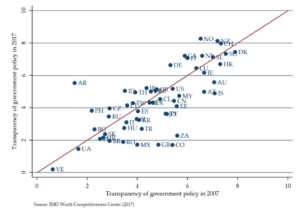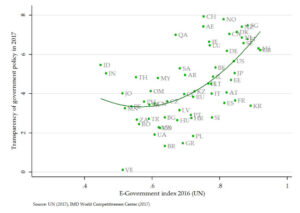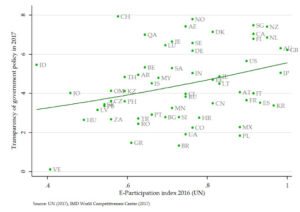
Government transparency: Are we better off than a decade ago?
Transparency on the government level has been a key issue for more than a decade. Theoretical and empirical work along with the advocacy of NGOs have strengthened the idea, have suggested ways to measure it, and have kept the issue on the forefront of any discussion about the necessary conditions that a high-quality government must follow.
In the criteria employed by the IMD World Competitiveness Center, the concept of transparency is captured in the Executive Opinion Survey where mid- and upper-level managers are asked whether the “Transparency of government policy” is satisfactory or not. This issue of the Criterion of the Month explores the evolution of this perception in the last ten years.
Graph 1 presents a rather alarming picture. The horizontal axis reports the answers of the executives on a scale from 0 to 10 in 2007. The vertical axis conveys the perceptions for 2017. The red line represents the 45 degree curve. If the executives of a country perceive that the government transparency has been equally satisfactory in 2007 and 2017, then the country will be in the 45° red line.
All the countries that fall below the red line reflect economies where the respondents feel that the transparency of governmental policies is poorer in 2017 compared to 2007. Colombia exhibits the most profound change in this direction: the satisfaction with governmental transparency has declined by almost 70% in the last ten years.
Conversely, the countries that lie above the 45° line enjoy a greater satisfaction with respect to government transparency in 2017 than they did a decade ago. The highest change has been realized in Argentina with a three-fold increase in governmental transparency.
The alarming story that the graph describes is that, compared to 2007, in 60% of the countries we study (33 out of 55) the respondents perceive the governments to be less transparent in their policies. From a regional point of view, the largest share of countries that realized a decline in the perception of transparency is Latin America while the lowest share has been in Southern Asia.
How can this trend be reversed in the next decade? Undoubtedly many interesting research projects will attempt to provide insights into this. Using available data, we can check whether there is any relationship between the levels of government transparency and new innovative ways of involvement allowed by the digital revolution.
Many governments attempt to deliver basic economic and social services to their countries by using information and communication technologies (ICTs). This e-government development is measured by the UN’s E-Government Survey in the stated hope that it, among other things, will promote transparency.
Graph 2 depicts the relationship between transparency and the most recent e-government index. No clear relationship can be identified. Compare, for instance, Switzerland and Slovenia, two countries, which for the same approximate level of e-government, enjoy substantially different levels of transparency. The correlation coefficient is 0.54.
Instead of relating transparency to the provision of services, it would be perhaps instructive to correlate it with the participation of citizenry in public life. E-participation captures exactly this: access to information, participation in decision making and provision of feedback to state decision makers.
Graph 3 illustrates the relationship between transparency of government policy and the most recent e-participation index provided by the UN. The graph shows that, for the time being at least, e-participation does not relate with transparency and therefore it would be difficult to have any effect on it. Again, compare Norway and Brazil, which for the same approximate level of e-participation exhibit quite different levels of transparency. The correlation coefficient at 0.32 suggests two variables that have almost no relationship.
Indisputably, transparency of government policy decision making is an important component of evaluating the quality of a government. High levels of transparency strengthen citizens’ trust in governments, which in turn fosters a sense of loyalty, inclusiveness and higher participation in the operation of the community in addition to boosting the economy. Interestingly, I offer results that are … counterintuitive.
We observed a decline in the perception of government transparency during the last decade. This can be the outcome of increased ‘transparency standards’ among the respondents in the last decade. It can also suggest that the proliferation of information may also result in increased ‘noise’. ICT involvement may foster transparency by incorporating the insights of citizens and making services more accessible. Yet, in our dataset, the expected positive effect of e-government and e-participation has not been achieved. Possibly, this is an example that brings forward the importance of implementation. Appealing concepts and best practices may not provide the anticipated outcome not because they are not initiated but because they are not implemented in an efficient manner. And this is an issue that needs to be examined carefully.
Research Information & Knowledge Hub for additional information on IMD publications
In this note, I offer a framework to help business leaders cope with the duality of geopolitical conflict and stakeholder scrutiny. CEOs increasing...
In Switzerland, the battle over the future regulation of the banking sector is raging behind the scenes. The state and the National Bank do not wan...
IMD produces a yearly Smart City Index offering a balanced focus on economic and technological aspects of smart cities on the one hand, and “humane...
In 1983, Korean Air Lines Flight KE007, a Boeing 747, suffered a tragic fate that claimed the lives of all 269 passengers and crew. Against the bac...
The EU Emissions Trading System incentivises firm-level innovation away from carbon-intensive technologies through price signalling. This column ex...
Venezuela is engulfed in a political and economic crisis, which has forced over 6 million people – some 20% of the population – to flee the country...
Since the start of the Ukraine war, the US, EU, UK and other countries including Japan and Canada have increased sanctions on Russia. By late 2023,...
Research Information & Knowledge Hub for additional information on IMD publications
Research Information & Knowledge Hub for additional information on IMD publications
IMD World Competitiveness Center Report, 8 April 2024
Research Information & Knowledge Hub for additional information on IMD publications
Research Information & Knowledge Hub for additional information on IMD publications
in VoxEU 12 March 2024
Research Information & Knowledge Hub for additional information on IMD publications
in The Conversation 11 March 2024
Research Information & Knowledge Hub for additional information on IMD publications
in I by IMD 5 March 2024
Research Information & Knowledge Hub for additional information on IMD publications
in The Conversation 4 March 2024
Research Information & Knowledge Hub for additional information on IMD publications
Research Information & Knowledge Hub for additional information on IMD publications
in I by IMD 6 February 2024
Research Information & Knowledge Hub for additional information on IMD publications





